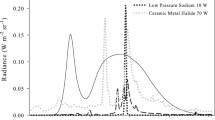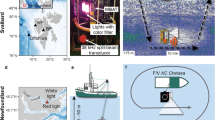Abstract
The underwater light field in the Bellingshausen andAdmundsen Seas was characterised using data collectedduring the R/V Polarstern cruise ANT XI/3, from12.1.94 to 27.3.94. The euphotic zone varied from 24to 100 m depth. Spectral diffuse vertical attenuationcoefficients (K d (λ))were determined for 12narrow wavebands as well as for photosyntheticallyavailable radiation (PAR, 400–700 nm): K d (490)ranged from 0.03 to 0.26 m™1; K d (550) from0.04 to 0.17 m™1; K d (683) from 0.04 to0.17 m™1; and K d (PAR) varied from 0.02 to0.25 m™1. K d (λ) for wavelengths centred at412 nm, 443 nm, 465 nm, 490 nm, 510 nm, 520 nm and550 nm were significantly correlated with chlorophyllconcentration (ranging from 0.1 to 6 mg m™3). Thevertical attenuation coefficients for 340 nm and380 nm ranged from 0.10 to 0.69 m™1 and from 0.05to 0.34 m™1, respectively, and were also highlycorrelated with chlorophyll concentrations. These K d values indicate that the 1% penetration depthmay reach maxima of 46 m and 92 m for 340 nm and380 nm, respectively. The spectral radiancereflectances (Rr(λ)) for 443 nm, 510 nm and 550 nmwere less than 0.01 sr™1. Rr(λ) for 665 nm and683 nm increased with depth up to 0.2 sr™1 because ofchlorophyll fluorescence. Using a model that predicts downwardirradiances by taking into account the attenuation bywater and absorption by chlorophyll, we show thatchlorophyll fluorescence has a significant influenceon the red downward irradiance (E d (633, 665, 683))in deeper layers. The ability of the phytoplanktonpopulation to influence the light environment byautofluorescence and absorption processes depends onthe light conditions and on the photoacclimation ofthe cells, represented by the in vivo crosssection absorption coefficient of chlorophyll (a*). Theobtained mean chlorophyll-specific light attenuationcoefficients of phytoplankton in situ (k d ) are higherthan the in vivo absorption coefficient of chlorophyll,more than to be excepted from the scattering. a*(λ), m2 mg chl™1, decreased due topackaging effect with increasing chlorophyllconcentrations.
Similar content being viewed by others
References
Arrigo, K. R., 1994. Impact of ozone depletion on phytoplankton growth in the Southern Ocean: large-scale spatial and temporal variability. Mar. Ecol. Prog. Ser. 114: 1–12.
Arrigo, K. R. & C. R. McClain, 1994. Spring phytoplankton production in the Western Ross Sea. Science 266: 261–263.
Baar, H. J. W. de, J. T. M. Jong de, D. C. E. Bakker, B. M., Loscher, C. Veth, U. Bathman & V. S. Smetacek, 1995. Importance of iron for plankton blooms and carbon dioxide drawdown in the Southern Ocean. Nature 373: 412–415.
Bannister, T. T., 1974. Production equation in terms of chlorophyll concentration, quantum yield, and upper limit to production. Limnol. Oceanogr. 19: 1–12.
Berner, T., K. Wyman, Z. Dubinsky & P. G. Falkowski, 1989. Photoadaptation and the ‘package effect’ in Dunaliella tertioleca (Chlorophyeae). J. Phycol. 25: 70–78.
Bricaud, A. & D. Stramski, 1990. Spectral absorption coefficients of living phytoplankton and nonalgal biogenous matter: a comparison between the Peru upwelling area and the Sargasso sea. Limnol. Ocanogr. 35: 562–582.
Bristow, M., D. Nielsen, D. Bundy & R. Furtek, 1981. Use of water Raman emission to correct airborne laser fluorosensor data for effects of water optical attenuation. Appl. Opt. 20: 2889–2906.
Dubinsky, Z., 1992. The functional and optical absorption cross–sections of phytoplankton photosynthesis. In Falkowski, P. G. & A. D. Woodhead (eds), Primary Productivity and Biogeochemical Cycles in the Sea. Plenum Press, New York: 31–45.
El Sayed, E. Z., 1970. On productivity of the Southern Ocean (Atlantic and Pacific sectors). In Holdgate, M. W. (ed.), Antarctic Ecology. Academic Press, New York: 119–135.
Fenton, N., J. Priddle & P. Tett, 1994. Regional variations in biooptical properties of the surface waters in the Southern ocean. Ant. Sci. 6: 443–448.
Jerlov, N. G., 1976. Elsevier Oceanography Series, 14. Marine Optics. Elsevier Amsterdam, 231 pp.
Helbling, W., V. Villafane & O. Holm-Hansen, 1994. Effect of ultraviolet radiation on Antarctic marine phytoplankton photosynthesis with particular attention to the influence of mixing. In Weiler, C. S. & P. A. Penhale (eds), Ultraviolet Radiation in Antarctica: Measurements and Biological Effects. Antarctic Research Series 62, American Geophysical Union Washington: 207–227.
Holm-Hansen, O., E. W. Helbling, & D. Lubin, 1993. Ultraviolet radiation in Antarctica: inhibition of primary production. Photocem. Photobiol. 58: 567–570.
Holm-Hansen, O., A. F. Amos, N. S. Silva, V. Villafane, & E. W. Helbing, 1994. In situevidence for a nutrient limitation of phytoplankton growth in pelagic Antarctic waters. Ant. Sci. 6: 315–324.
Kiefer, D. A. & J. B. Soohoo, 1982. Spectral absorption by marine particles of coastal waters of Baja California. Limnol. Oceanogr. 27: 492–499.
Kirk, J. T. O., 1994. Light and photosynthesis in aquatic ecosystems. Cambridge University Press, London, 509 pp.
Konig Lango, G., 1994. The meteorological data of the Georg-von Neumayer Station (Antarctica) for 1988, 1989, 1990 and 1991. Reports on Polar Research Vol. 116. Alfred Wegener Institute for Polar and Marine Research. Bremerhaven. Germany, 70 pp.
Lizotte, M. P. & J. C. Priscu, 1992. Spectral irradiance and biooptical properties in perennially ice-covered lakes of the dry valleys (McMurdo Sound, Antarctica). Antarctic Res. Ser. 57: 1–14.
Longhurst, A., S. Sathyendranath, T. Platt & C. Caverhill, 1995. An estimate of global primary production in the ocean from satellite radiometer data. J. Plankton Res. 17: 1245–1271.
Mitchell, B. G & D. A. Kiefer, 1988. Chlorophyll a specific absorption and fluorescence excitation spectra for light-limited phytoplankton. Deep-Sea Res. 35: 639–663.
Mitchell, B. G. & O. Holm-Hansen, 1991. Bio-Optical properties of Antarctic Peninsula waters: differentiation from temperate ocean models. Deep Sea Res. 38: 1009–1028.
Mitchell, B. G., E. A. Brody, O. Holm-Hansen, C. McClain & J. Bishop, 1991. Light limitation of phytoplankton biomass and macronutrient utilization in the Southern Ocean. Limnol. Oceanogr. 36: 1662–1677.
Morel, A., 1988. Optical modelling of the upper ocean in relation to its biogenous matter content (Case I Waters). J. geophys. Res. 93: 10749–10768.
Morel, A. & L. Prieur, 1977. Analysis of variations in ocean color. Limnol Oceanogr. 22: 709–722.
Prezelin, B. B., N. P. Boucher, & R. C. Smith, 1994. Marine primary production under the influence of the Antarctic ozone hole: ICECOLORS ’90. In Weiler, C. S. & P. A. Penhale (eds), Ultraviolet Radiation in Antarctica: Measurements and Biological Effects, Antarctic Research Series 62, American Geophysical Union Washington: 159–186.
Roesler, C. S. &. M. J. Perry, 1989. Modelling in situphytoplankton absorption from total absorption spectra in productive inland marine waters. Limnol. Oceanogr. 34: 1510–1523.
Schmidt, T. & G. Konig Lango, 1994. Radiation measurements at the German Antarctic Station Neumayer 1982–1992. Reports on Polar Research Vol. 146. Alfred Wegener Institute for Polar and Marine Research. Bremerhaven. Germany, 66 pp.
Siegel, D. A. & T. D. Dickey, 1987. Observations of the vertical structure of the diffuse attenuation coefficient spectrum. Deep Sea Res. 34: 547–563.
Smith, R. C. & K. S. Baker, 1978. The bio-optical state of ocean waters and remonte sensing. Limnol. Oceanogr. 23: 247–259.
Smith, R. C. & K. S. Baker, 1981. Optical properties of the clearest natural waters (200–800 nm). Appl. Opt. 20: 177–184.
Smith, R. C., B. B. Prezlin, K. S. Baker, R. R. Bidigare, N. P. Bocher, T. Coley, D. Karentz, S. MacIntyre, H. A. Matlick, D. Menzies, M. Ondrusek, Z. Wan, & K. J. Waters, 1992a. Ozone depletion; ultraviolet radiation and phytoplankton biology in Antarctic waters. Science 255: 952–959.
Smith, R. C., Z. Wan, & K. S. Baker, 1992b. Ozone depletion in Antarctica: modelling its effect on solar UV irradiance under clear sky conditions. J. geophys. Res. 97: 7383–7397.
Stambler, N., R. Reynolds, A. Bracher, U. Hoge & M. M. Tilzer, 1996. Biooptic. In Miller, H. & H. Grobe (eds), The Expedition Antarktis–XI/3 of the RV "Polarstern": in 1994. Reports on Polar Research Vol. 188. Alfred Wegener Institute for Polar and Marine Research. Bremerhaven. Germany: 58–64.
Tilzer, M. M., W. W. Gieskes, R. Heusel, & N. Fenton, 1994. The impact of phytoplankton on spectral water transparency in the Southern Ocean: implications for primary productivity. Polar Biol. 14: 127–136.
Tilzer, M. M., N. Stambler & C. Lovengreen, 1995. The role of phytoplankton in determining the underwater light climate in Lake Constance. Hydrobiologia 316: 161–172.
Walker, R. E., 1994. Marine light field statistics. John Wiley & Sons, INC. New York, 675 pp.
Weiler, C. S. & P. A. Penhale (eds), 1994. Ultraviolet radiation in Antarctica: measurements and biological effects. Antarctic Research Series 62. American Geophysical Union Washington, 257 pp.
Yentsch C. S. & C. M. Yentsch, 1979. Fluorescence spectral signatures: the characterization of phytoplankton populations by the use of excitation and emission spectra. J. Mar. Res. 37: 471–483.
Yentsch C. S. & C. M. Yentsch, 1982. The attenuation of light by marine phytoplankton with specific reference to the absorption of near–UV radiation. In Calkins, J. (ed.), The Role of Solar Ultraviolet Radiation in Marine Ecosystem, Plenum Press, New York: 691–700.
Author information
Authors and Affiliations
Rights and permissions
About this article
Cite this article
Stambler, N., Lovengreen, C. & Tilzer, M.M. The underwater light field in the Bellingshausen and Amundsen Seas (Antarctica). Hydrobiologia 344, 41–56 (1997). https://doi.org/10.1023/A:1002993925441
Issue Date:
DOI: https://doi.org/10.1023/A:1002993925441




